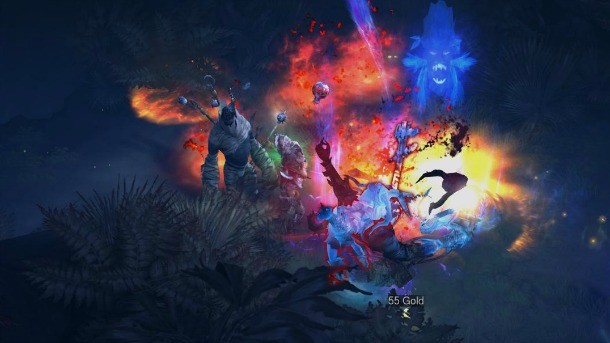Please support Game Informer. Print magazine subscriptions are less than $2 per issue
Why The Diablo III Auction House Was Inevitable

The auction houses change the way that the excitement of loot drops plays out, yes, but the fact of the matter is that Diablo III is the first Diablo game to make so much as a token effort at balancing skills, monsters, items, and classes -- and without the auction house, either the loot system would have to be radically changed or we’d still be grinding Nightmare difficulty for class-appropriate drops.
Any argument that any previous Diablo game was anywhere close to the level of balance that Diablo III is a joke. I’ve played them all to death, and while my love for the series knows no bounds, the only “balance” previous to Diablo III was how quickly your build and equipment could plow through your loot run of choice. Diablo III is still ludicrously easy through normal mode for anyone familiar with the series, but the difficulty in Hell and especially Inferno is far beyond anything but the goofy Uber Tristram challenge mode patched in at the end of Diablo II’s life cycle.
Once the decision was made to balance the game, instead of allowing only a handful of brokenly powerful builds into the hardest content like in Diablo II, a chain of game-design dominoes that necessarily ends either with something like an auction house or a game barely recognizable as Diablo began to fall into place.
1. To have any kind of difficulty prior to max level, baselines of damage input and output relative to health pools has to be established. Absent intentionally overpowered legendary gear that a low- or mid-level character will only have as a gift from a higher-level hero (or an influx of real money), character power needs to fall within a certain range for progressing to be possible but challenging enough to be interesting. (I would argue that Blizzard missed the mark by making normal too easy and Inferno too difficult, but that’s beside the point.)
2. Loot is the largest part of that equation. With skills unlocking by level, loot and player skill are the two variables that move the needle on challenge. Aside from trying to guide players toward effective baseline strategies through skill progression and monster design, designers can’t do much about player skill. Without changing the way that equipment works to the point that you’re not making a Diablo game any more, that leaves loot as the by-far dominant determinant of difficulty.
3. Diablo’s loot is random to a nearly absurd extent. This has been a (arguably, the) core tenet of the franchise ever since its inception. Players, myself included, would have revolted against deterministic MMO-style loot drops in Diablo III. With a recognizably Diablo-style loot system, any given character’s power is going to be hugely dependent on finding a class- and build-appropriate weapon near their level, and to a lesser extent other equipment.
4. Therefore, the bulk of the game’s challenge is determined by whether or not you happened to find a slow two-hander with lots of strength on it, or a pair of fast fist weapons, or whatever your build calls for. Few designers, and certainly not modern Blizzard developers, are going to leave that entirely to chance.
5. Solving that can take three forms: Make weapons and other gear less impactful (not going to happen in Diablo), consign players to hours of grinding for every tiny scrap of progression past normal mode (not likely in a modern mainstream game), or facilitate trading between players so that you can find what you need -- for a price. Voila, the auction house is born.
I can respect the argument that I’ve seen bandied about by disappointed Diablo fans that would have preferred the series’ traditional grind-for-hours solution. I have a fair amount of sympathy for that viewpoint, having leapt out of my chair when I found my first Harlequin Crest and specifically rolled a javelin-using amazon to use the ethereal Titan’s Revenge that dropped for my sorceress. I would have made the same decision Blizzard ultimately did, though, for two reasons. One, nothing forces you to use the auction house -- if you want to only use dropped equipment or trade only with your friends, nothing is stopping you. Second, while gold can buy just about anything on the auction house in sufficient quantities, the only real way to amass the kind of wealth needed for top-end gear is to go find it yourself. The triple-digit dexterity/resist all/attack speed amulet I found was just as exciting as my first Oculus, even though it dropped for my barbarian -- the gold I sold it for turned into a huge upgrade for the barbarian, without the soul-crushingly awful experience that trading a similarly powerful item would have been in Diablo II.
That was before the attack-speed nerf, of course [grumble, grumble]. Oh well, that’s what witch doctors are for!










